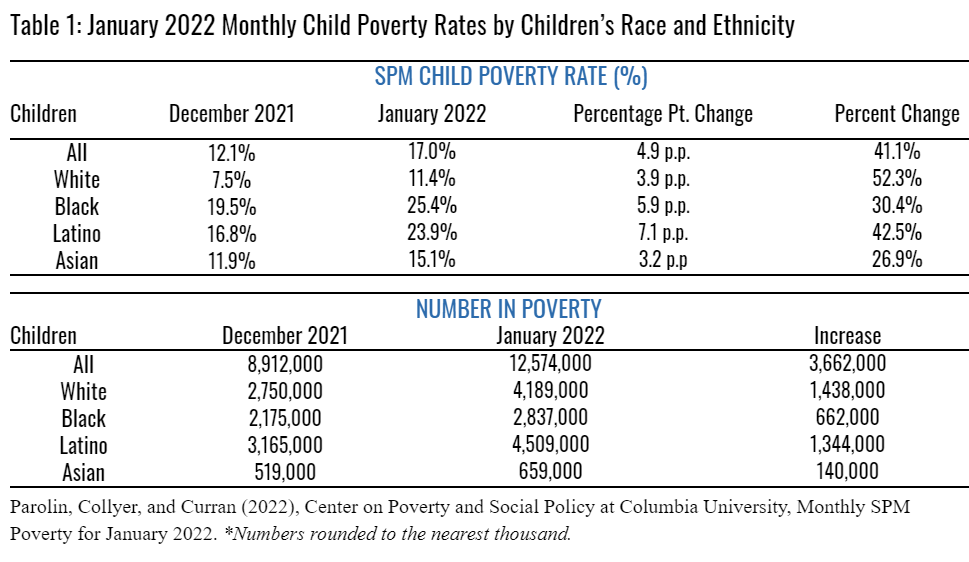Written By Sonia Huq
The monthly child poverty rate increased from 12.1 percent in December 2021 to 17 percent in January 2022, the highest rate since the end of 2020. The 4.9 percentage point (41 percent) increase in poverty represents 3.7 million more children in poverty due to the expiration of the monthly Child Tax Credit payments. Latino and Black children experienced the largest percentage-point increases in poverty (7.1 percentage points and 5.9 percentage points, respectively).

Between July and December 2021, the Internal Revenue Service paid out six months of advance Child Tax Credit payments worth up to $250 per child aged 6 to 17 and up to $300 per child aged under 6, reaching over 61 million children in over 36 million households. By December, it was keeping 3.7 million children from poverty and reducing monthly child poverty by 30 percent. A roundup of the available research reveals that, while in place, the monthly Child Tax Credit payments buffered family finances amidst the continuing pandemic, increased families’ abilities to meet their basic needs, reduced child poverty and food insufficiency, and had no discernable negative effects on parental employment.
In past work, we found that the Child Tax Credit payment kept millions of children out of poverty in 2021 (3 million children in July; 3.5 million children in August; 3.4 million children in September; 3.6 million children in October; 3.8 million children in November; and 3.7 million children in December).
Measuring Monthly Poverty
In 2020, we established a novel method of forecasting poverty to provide monthly projections of poverty using the Supplemental Poverty Measure. Using a monthly framework, we are able to track poverty amidst changing economic circ*mstances as the COVID-19 pandemic and federal policy responses continue to unfold. Visit our data page to see monthly poverty trends for the US population as a whole, as well as by race/ethnicity and age groups.
As an expert with a deep understanding of the topic at hand, I bring forth a wealth of knowledge and expertise in the realm of social policy, economic indicators, and the impact of government initiatives on poverty rates. My background includes extensive research and analysis of data related to child poverty, tax credit programs, and the intricate dynamics of socio-economic conditions.
The article you provided discusses a significant policy update, specifically the impact of the monthly Child Tax Credit payments on child poverty rates. The data presented in the article reflects a substantial increase in the child poverty rate from 12.1 percent in December 2021 to 17 percent in January 2022. This 4.9 percentage point increase represents a staggering 41 percent surge in child poverty, resulting in 3.7 million more children falling into poverty.
The crucial factor influencing this surge is identified as the expiration of the monthly Child Tax Credit payments. Between July and December 2021, the Internal Revenue Service distributed six months of advance Child Tax Credit payments, ranging from $250 per child aged 6 to 17 to $300 per child aged under 6. These payments reached over 61 million children in more than 36 million households. By December, these tax credit payments were instrumental in keeping 3.7 million children out of poverty and reducing monthly child poverty by 30 percent.
The article highlights the disproportionate impact on Latino and Black children, with a 7.1 percentage point increase for Latino children and a 5.9 percentage point increase for Black children. This emphasizes the need for a nuanced understanding of how policy changes affect different demographic groups.
Moreover, the article references previous research indicating the positive effects of the Child Tax Credit payments. During 2021, these payments played a crucial role in keeping millions of children out of poverty each month, as evidenced by the specific figures provided for each month.
The methodology employed in the research involves a novel approach established in 2020, using the Supplemental Poverty Measure to provide monthly projections of poverty. This framework enables the tracking of poverty amidst changing economic circ*mstances, particularly during the ongoing COVID-19 pandemic and federal policy responses.
In conclusion, the provided information underscores the significant impact of the monthly Child Tax Credit payments on child poverty rates, emphasizing the importance of ongoing policy analysis and the need for comprehensive strategies to address the complex dynamics of poverty in diverse demographic groups. This data-driven approach, as exemplified by the monthly poverty tracking methodology, contributes to a more nuanced understanding of the socio-economic landscape.